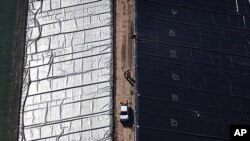An Australian mining company says it could start exploring for coal seam gas next year beneath the country's most populous city, Sydney. Some residents are worried the extraction process could contaminate their water supplies and are mobilizing a large campaign against plans to mine near their homes. The methane gas industry insists the technology is safe and will bring immense economic benefits.
"We formed [a protest group], I think in November of last year, when a bunch of residents found out there was [a] plan to drill for coal seam gas in Saint Peters. We are seriously concerned about the impacts of this industry not just here in Saint Peters, but more broadly across New South Wales, particularly on precious water and our health," a speaker at the Anti-CSG demonstration in Sydney said.
Campaigners worry that Australia's coal seam gas industry is expanding too quickly and that the long-term effects of drilling close to residential areas are unknown. With expanding energy needs across Asia, analysts estimate Australia will try to meet the demand by building at least 20,000 coal seam gas wells by 2030.
In the Sydney suburb of Saint Peters, Jacinta Green has been leading opposition to the methane gas industry. She believes it could eventually encroach right across this densely populated part of Australia.
"If this well goes ahead in Saint Peters and the need to access this gas resource from [the] Sydney basin is so great then there will be a gas well in every single suburb," said Green. "They can only extract the gas from a limited area. To get the gas out, to fully utilize that resource, they have to put a gas well every 10 kilometers."
Jacinta's house is a couple of minutes walk from the site in Saint Peters.
"If this project gets the go-ahead I will be down here every day," Green said. "I will be watching the site like a hawk. We will be barricading the streets the second we see that drill rig move in here."
The proposed drilling site now lies behind huge locked gates. The mining company that holds an exploration license that covers most of the Sydney region says it has no firm plans to extract coal seam gas in Saint Peters.
"Now whilst visiting the site and, lo and behold, behind me I witnessed a coal seam gas well suddenly explode," said Jeremy Buckingham, a New South Wales state parliament Greens Member of Parliament.
Buckingham described an accident at a drilling site on the outskirts of Sydney, earlier this year. He wants a moratorium on the industry until more research is done into the effects of coal seam gas.
"There are a range of concerns," Buckingham added. "They have not been dealt with. We don't have the science and yet the industry is rolling out and so people are worried about the impacts of coal seam gas on ground water, on surface water. They are worried about coal seam gas and its impacts on our climate, leaks of methane and what impact that is going to have on climate, so there's a range of environmental issues."
This gas is trapped in underground reserves of coal. When water is pumped out the methane is released. Fracking, the process of re-injecting water and other chemicals to release gas, is not commonly used in the exploitation of Australian coal seams. Instead, horizontal drilling is usually favored.
In eastern Australia, it is estimated there is enough gas to power a city of five million people for 1,000 years.
The industry, which is dominated by multinational corporations, believes the more people know about coal seam gas the less they will fear it. Television advertisements have tried to sooth anxiety in the community.
"It is very safe. It is a well-proven technology and it is not materially different from the same natural gas production techniques that we have been using in Australia for nearly half a century now," said Rick Wilkinson of the Australian Petroleum Production and Exploration Association.
Wilkinson is predicting a coal seam gas boom for Australia. "We are very close to energy-hungry Asia. Does not matter whether it is Japan, Korea - the traditional markets - or China and India that are all going to grow. They will need more and more energy and gas is a fantastic result. It is cleaner than all of the fossil fuels and will help transition to the renewable future," Wilkinson added.
Most of Australia's 2,700 coal seam gas wells are in Queensland. Thousands more could follow, but before approval is given the fight between economic opportunity and environmental sensitivities will continue.











